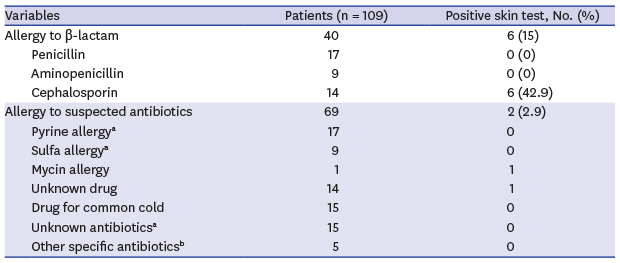1. Torres MJ, Blanca M, Fernandez J, Romano A, Weck A, Aberer W, et al. Diagnosis of immediate allergic reactions to beta-lactam antibiotics. Allergy. 2003; 58(10):961–972.
2. Annè S, Reisman RE. Risk of administering cephalosporin antibiotics to patients with histories of penicillin allergy. Ann Allergy Asthma Immunol. 1995; 74(2):167–170.
3. Arroliga ME, Wagner W, Bobek MB, Hoffman-Hogg L, Gordon SM, Arroliga AC. A pilot study of penicillin skin testing in patients with a history of penicillin allergy admitted to a medical ICU. Chest. 2000; 118(4):1106–1108.
4. Greenberger PA. 8. Drug allergy. J Allergy Clin Immunol. 2006; 117(2):Suppl Mini-Primer. S464–S470.
5. Torres MJ, Blanca M, Fernandez J, Romano A, Weck A, Aberer W, et al. Diagnosis of immediate allergic reactions to beta-lactam antibiotics. Allergy. 2003; 58(10):961–972.
6. Torres MJ, Celik GE, Whitaker P, Atanaskovic-Markovic M, Barbaud A, Bircher A, et al. A EAACI drug allergy interest group survey on how European allergy specialists deal with β-lactam allergy. Allergy. 2019; 74(6):1052–1062.
7. Lin RY. A perspective on penicillin allergy. Arch Intern Med. 1992; 152(5):930–937.
8. Li JT, Markus PJ, Osmon DR, Estes L, Gosselin VA, Hanssen AD. Reduction of vancomycin use in orthopedic patients with a history of antibiotic allergy. Mayo Clin Proc. 2000; 75(9):902–906.
9. Doña I, Blanca-López N, Torres MJ, García-Campos J, García-Núñez I, Gómez F, et al. Drug hypersensitivity reactions: response patterns, drug involved, and temporal variations in a large series of patients. J Investig Allergol Clin Immunol. 2012; 22(5):363–371.
10. Lee SH, Park HW, Kim SH, Chang YS, Kim SS, Cho SH, et al. The current practice of skin testing for antibiotics in Korean hospitals. Korean J Intern Med. 2010; 25(2):207–212.
11. International Collaborative Study of Severe Anaphylaxis. Risk of anaphylaxis in a hospital population in relation to the use of various drugs: an international study. Pharmacoepidemiol Drug Saf. 2003; 12(3):195–202.
12. Ribeiro-Vaz I, Marques J, Demoly P, Polónia J, Gomes ER. Drug-induced anaphylaxis: a decade review of reporting to the Portuguese Pharmacovigilance Authority. Eur J Clin Pharmacol. 2013; 69(3):673–681.
13. Lange L, Koningsbruggen SV, Rietschel E. Questionnaire-based survey of lifetime-prevalence and character of allergic drug reactions in German children. Pediatr Allergy Immunol. 2008; 19(7):634–638.
14. Yang MS, Lee SH, Kim TW, Kwon JW, Lee SM, Kim SH, et al. Epidemiologic and clinical features of anaphylaxis in Korea. Ann Allergy Asthma Immunol. 2008; 100(1):31–36.
15. Brockow K, Romano A, Blanca M, Ring J, Pichler W, Demoly P. General considerations for skin test procedures in the diagnosis of drug hypersensitivity. Allergy. 2002; 57(1):45–51.
16. Yang MS, Kang DY, Seo B, Park HJ, Park SY, Kim MY, et al. Incidence of cephalosporin-induced anaphylaxis and clinical efficacy of screening intradermal tests with cephalosporins: a large multicenter retrospective cohort study. Allergy. 2018; 73(9):1833–1841.
17. Madaan A, Li JT. Cephalosporin allergy. Immunol Allergy Clin North Am. 2004; 24(3):463–476. vi–vii.
18. Norrby SR. Side effects of cephalosporins. Drugs. 1987; 34:Suppl 2. 105–120.
19. Kelkar PS, Li JT. Cephalosporin allergy. N Engl J Med. 2001; 345(11):804–809.
20. Seo DH, Yu HJ, Sohn SJ. Dermographism: I. The prevalence in Korean general population. Korean J Dermatol. 1986; 24:340–344.
21. Blanca M, Romano A, Torres MJ, Férnandez J, Mayorga C, Rodriguez J, et al. Update on the evaluation of hypersensitivity reactions to betalactams. Allergy. 2009; 64(2):183–193.
22. Yoon SY, Park SY, Kim S, Lee T, Lee YS, Kwon HS, et al. Validation of the cephalosporin intradermal skin test for predicting immediate hypersensitivity: a prospective study with drug challenge. Allergy. 2013; 68(7):938–944.
23. Antunez C, Blanca-Lopez N, Torres MJ, Mayorga C, Perez-Inestrosa E, Montañez MI, et al. Immediate allergic reactions to cephalosporins: evaluation of cross-reactivity with a panel of penicillins and cephalosporins. J Allergy Clin Immunol. 2006; 117(2):404–410.
24. Romano A, Guéant-Rodriguez RM, Viola M, Amoghly F, Gaeta F, Nicolas JP, et al. Diagnosing immediate reactions to cephalosporins. Clin Exp Allergy. 2005; 35(9):1234–1242.
25. Kim MH, Lee JM. Diagnosis and management of immediate hypersensitivity reactions to cephalosporins. Allergy Asthma Immunol Res. 2014; 6(6):485–495.
26. Bousquet PJ, Pipet A, Bousquet-Rouanet L, Demoly P. Oral challenges are needed in the diagnosis of beta-lactam hypersensitivity. Clin Exp Allergy. 2008; 38(1):185–190.
27. Empedrad R, Darter AL, Earl HS, Gruchalla RS. Nonirritating intradermal skin test concentrations for commonly prescribed antibiotics. J Allergy Clin Immunol. 2003; 112(3):629–630.








 PDF
PDF Citation
Citation Print
Print




 XML Download
XML Download